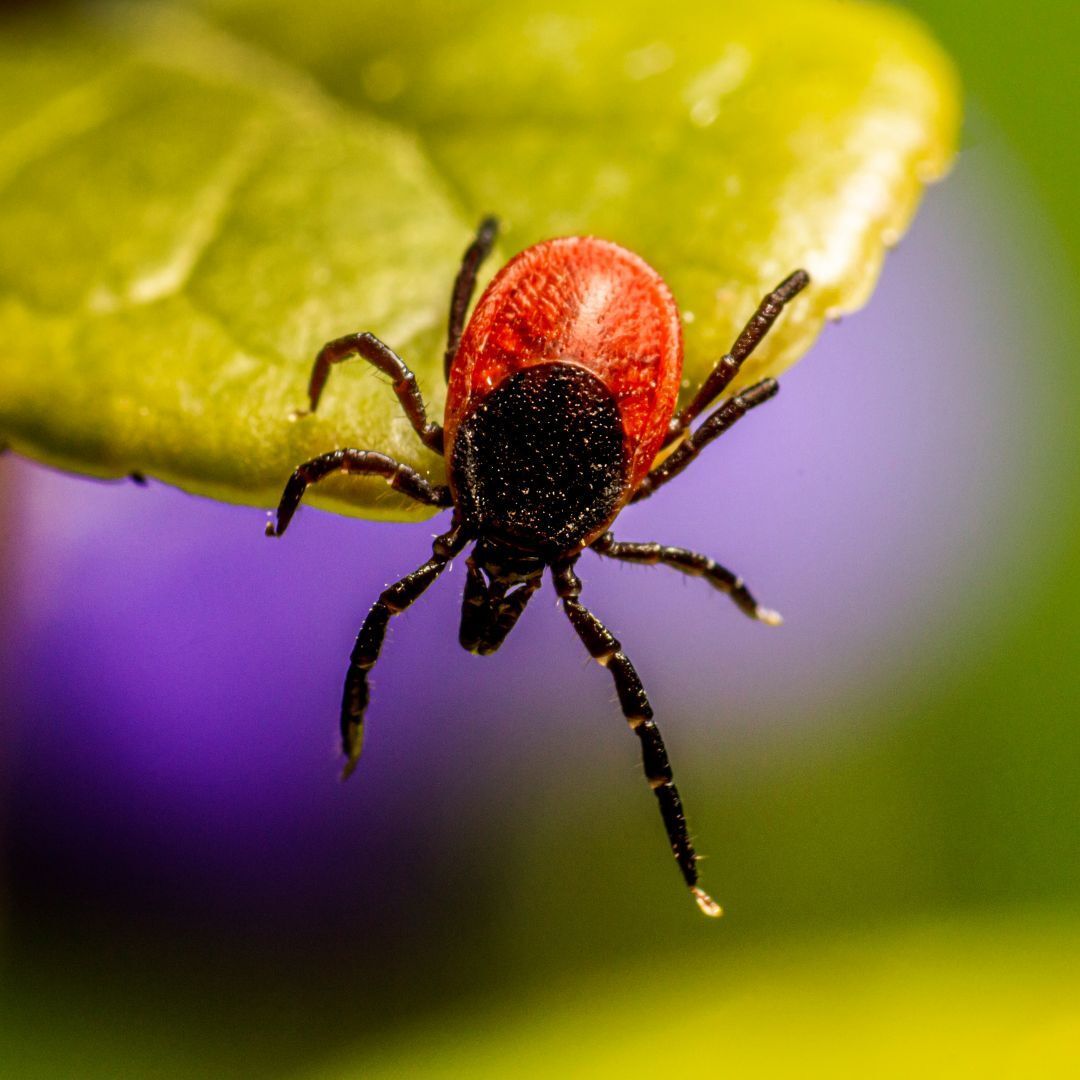Lyme disease: Why it’s on the rise and how to stay safe this spring
Lyme disease: Why it’s on the rise and how to stay safe this spring

Spring is here, and so are the ticks!
May is Lyme Disease Awareness Month and the charity, Lyme Disease UK, is urging the public to look out for these dangerous arachnids.
Every year, LDUK runs a Wake Up To Lyme campaign, which aims to raise awareness of how to prevent tick bites and what you should do if you’re bitten.
So what exactly is Lyme disease, and how can we steer clear from it this spring?
What is Lyme disease?
Lyme disease is an infection caused by a spiral-shaped bacteria called Borrelia burgdorferi. The infection is predominantly spread to humans through the bite of an infected tick.
Other infections that ticks can carry include Babesia, Bartonella, and rarely in the UK, the viral infection tick-borne encephalitis (TBE). Sometimes, ticks can transmit multiple infections through a single bite, and these can cause more severe symptoms and a more complicated clinical picture.
Official figures for 2021 are incomplete, but the government estimates there are around 3000-4000 cases of Lyme disease every year in England and Wales. However, research published in 2019 showed that real numbers could be at least three times higher.
Ticks have been found across every county of the UK and are mainly found in grassy areas and woodland, but have also been found in urban parks and gardens. It is estimated that around 10% of ticks in the UK carry Lyme disease.
Ticks vary in size and can be as small as a poppy seed, or as large as a baked bean after a blood meal.
Ticks live in grassy areas and look for food during an activity known as ‘questing’. A tick waits on a blade of grass for a human or animal to brush past it, transfers onto the host, and then crawls to find a warm spot to embed itself into.
They inject a local anaesthetic which means that their bite is painless, and often attach themselves to the hairline, axillae, or groin areas of the body, so many people don’t realise they’ve been bitten.
Why is Lyme disease on the rise?
Lyme disease is the most common tick-borne disease in the Northern Hemisphere.
Infected ticks can be found in every county of the UK, but some areas are known to pose a higher risk, including the Scottish Highlands, South and South West England, and parts of East Anglia. This map shows the distribution of ticks across the UK.
Since the UK’s first confirmed case in 1985, the recorded incidence of Lyme disease has steadily been increasing.
The reasons for this are complex, but may be related to climate change, as well as changes in land management and biodiversity.
Climate change
Studies indicate that ticks are showing earlier seasonal activity and a generally northward expansion in response to increasing temperatures associated with climate change. This is likely increasing the risk of human exposure to ticks.
Ticks are most active in early spring and summer, but with UK winters becoming warmer and wetter, Lyme Disease UK is receiving reports of tick bites throughout the year.
What makes viruses tick? - a project led by the Brennan Lab at the MRC-University of Glasgow Centre for Virus Research - has also noted tick sightings in winter, particularly on the Isle of Harris in the Western Isles, which is an area of the UK previously identified as having a climate that allows ticks to thrive.
Research due to be presented at the European Congress of Clinical Microbiology and Infectious Diseases this April also speculates whether ticks infected with TBE have been brought into the UK due to migratory birds and climate change.
Changes in land management and biodiversity
It is also possible that changes in land management and biodiversity are contributing towards the spread of Lyme disease.
It is thought that small mammal species, such as mice and voles, are the main reservoirs for Lyme disease, and any factors that alter their abundance can have an effect on tick density and tick infection rates.
“Urbanisation has led to a growing population of deer and mice, which are used by the ticks for blood meals, and that in turn increases the tick population,” the ecologist Matthias Leu told the Washington Post recently. “Flowers and bushes planted by homeowners are feeding the deer well.”
In 2021, a multi-million pound project called ‘Ticksolve’ was also launched to investigate the ecological conditions that enable tick-borne infections to spread, identify areas of the UK where the health risks are likely to be highest, and put forward possible solutions.
The project runs until 2025, and brings together scientists from the UK Centre for Ecology & Hydrology (UKCEH), the University of Liverpool, the University of Glasgow, and the UK Health Security Agency.
According to Dr Beth Purse, principal investigator of TickSolve: “Risks from tick-borne diseases are rising across Europe due to increases in woodland cover and deer numbers, as well as climate change. Throughout the UK, risks could be exacerbated by plans to expand woodland. To tackle the problem, we need to better understand why people are more likely to get bitten by ticks in certain woodlands and whether this risk can be reduced through land management, for example by introducing vegetation or fences that reduce deer movement or tick numbers.”
Pet ownership
Pet owners may be at increased risk of tick bites and should follow tick prevention methods.
In 2015, Bristol University carried out the largest ever UK study on ticks in dogs. The Big Tick Project found that one in three dogs checked at random during a visit to the vet were found to be carrying a tick, and 47% of owners were not aware that they too were at risk of infection from tick-borne diseases.
An increase in pet ownership during the coronavirus pandemic means that exposure to ticks is likely to have increased in more recent years. Last year, official statistics showed that 62% of UK households owned a pet, which is an all-time high.
How can we stay safe this spring?
- Take effective tick repellent on outdoor trips and a tick removal tool.
- Permethrin-treated outdoor clothing should also be considered for high-risk activities and occupations.
- Avoid walking through long grass and stick to pathways wherever possible.
- Wear light-coloured clothing, as this will make it easier to spot ticks and brush them off.
- Wear long sleeves and tuck trousers into socks.
- Shower and carry out a thorough tick check on yourself, children, and pets when you get home.
- Remember that ticks can be as small as poppy seeds, so careful checking is key. Pay special attention to the hairline and behind the ears of young children.
- Talk to your vet about tick prevention products for pets and check them daily for ticks.
How do I remove a tick?
Ticks should be removed using a tick removal tool, or a pair of very fine-tipped tweezers, making sure that all parts of the tick are removed. A tick remover should be an essential part of any first aid kit.
There is no minimum time a tick needs to be attached to pass on an infection. However, it should be removed as soon as possible.
Never pull off a tick with your fingers, normal tweezers, or any other unsuitable tool.
It is also very important not to smother a tick in oil, Vaseline, or any other substance to try to remove it. This can stress the tick and cause it to respond by regurgitating the contents of its stomach into the host’s bloodstream.
What are the symptoms of Lyme disease to look out for?
It's thought that around 10% of ticks in the UK carry Lyme disease, so if you’ve been bitten, it’s important to keep an eye out for any symptoms that may develop during the coming days, weeks, or months. Symptoms of Lyme disease may have a delayed onset and can fluctuate.
The most obvious sign of Lyme disease is an erythema migrans (EM) rash, often referred to as a bull’s-eye rash. This is diagnostic of the infection and treatment should be started straight away, without needing to wait for a blood test.
However, around a third of people with Lyme disease don’t develop this rash and its appearance can be atypical. It doesn’t always look like the more easily-identified ringed type rash, and can have a solid or bruise-like appearance and look very different on darker skins.
The behaviour of any rash after a tick bite is the most important thing to be aware of. An EM rash takes at least three days, and in some cases up to 3 months, to appear. It generally isn’t itchy, painful, or hot, and gradually spreads outwards. Redness or itchiness immediately after a tick bite is usually a histamine reaction.
Be aware that not everybody develops an EM rash, so it’s important to look out for other possible symptoms of Lyme disease such as: ‘summer flu’, headaches, stiff neck, facial palsy (especially in children), fatigue, joint and muscle pain, and generally feeling very unwell. Behavioural changes in small children often indicate that a child is unwell, as they are unable to articulate how they are feeling.
Blood tests for Lyme disease are not always reliable, so a clinical diagnosis sometimes needs to be made, based on a combination of medical history, symptoms, and exposure to ticks.
Doxycycline is usually the first-line treatment for adults and children over 12 years, and amoxicillin is prescribed for younger children. It is essential to be aware that treatment for children with Lyme disease is based on their age and weight, as the dosage is much higher than is usually prescribed for other infections.
The NHS does not normally recommend treating prophylactically unless pregnant or immunocompromised, although the RCGP Lyme disease toolkit does mention this for other types of high-risk cases.
The NICE guideline for treating Lyme disease was published in 2018, and doctors can refer to this if they are unsure about diagnosing or treating Lyme disease.
Why is preventing tick bites and raising awareness so important?
Raising awareness is crucial to limiting the number of cases of Lyme disease this spring.
With this in mind, Lyme Disease UK is asking the general public to take part in their annual Wake Up To Lyme awareness campaign this May.
"We don't want people to be scared of enjoying the outdoors, but rather that people go out armed with the facts and knowledge they need to protect themselves and others from Lyme disease. Early intervention is key, and getting that message out to the public is crucial." Natasha Metcalf, Co-founder and Chair of Lyme Disease UK.
Lyme disease is a serious illness that can have a huge impact on the lives of those suffering from the condition. A late diagnosis or misdiagnosis can lead to ongoing health issues, including neurological and cardiac problems.
Lyme disease patients are often misdiagnosed with ME/chronic fatigue syndrome, multiple sclerosis, fibromyalgia, arthritis, and depression.
However, it is a preventable and treatable illness, especially if caught early and treated immediately.
It is essential that doctors, as well as the general public, know how to prevent tick bites, what to do if someone is bitten, and the symptoms of Lyme disease to look out for. It's also crucial to bear in mind that blood tests for the infection are not reliable, and can provide false negative results.
There are no Lyme disease specialists within the NHS and the NICE guideline used by NHS doctors focuses on treating the acute stage of the illness. There are no guidelines or universally-accepted treatment protocols on how to treat people who are chronically ill, following a Lyme disease infection.
There's also no test for cure to indicate when Lyme disease has been eradicated, and more research is desperately needed.
Many Lyme patients end up exploring private treatment options as their only hope of recovery and the financial burden can be huge. Many patients are unable to work and unsuccessful in claiming disability benefits.
How can the general public take part in Lyme Disease Awareness Month this May?
Lyme Disease UK’s annual Wake Up To Lyme campaign this May aims to raise awareness of how to prevent tick bites and what you should do if you’re bitten.
There are 10 top ways the general public can take part in Lyme Disease Awareness Month this May:
- Share Lyme Disease UK’s awareness materials.
- Purchase Botanic Protect tick repellent to wear during outdoor activities.
- Wear lime for Lyme with your pets on the 5th of May.
- Join in Lyme Disease UK’s schools campaign.
- Share your Lyme disease patient story.
- Write to your GP, pharmacist, or health professional.
- Email photos of any ticks you spot with a location for LDUK’s #TickWatch feature.
- Update your profile photo on social media with LDUK’s campaign logo.
- Ask your favourite landmark to light up for Lyme.
- Host a fundraising or awareness event.
Further details on how to take part in Lyme Disease Awareness Month can be found here.


